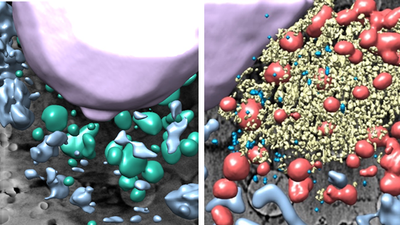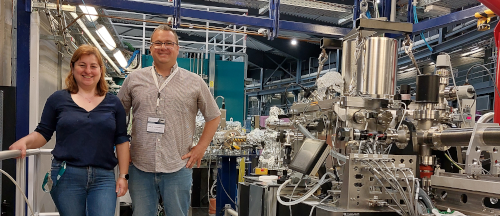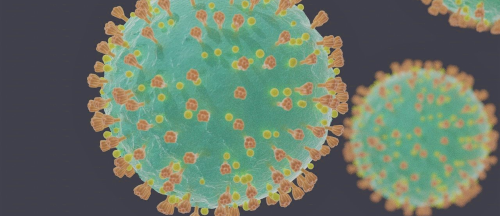
Three-dimensional images of a fragment of a control cell (left) and a cell infected with SARS-CoV-2 (right). The cell nucleus is highlighted in purple, healthy mitochondria in green, and mitochondria modified by the infection in red, the vacuoles in light blue, the viral factory in yellow and the viral particles in blue. / ALBA Synchrotron/CNB-CSIC
Cerdanyola del Vallès, 14th November 2023 The covid-19 pandemic has affected more than 770 million people and has caused the death of nearly seven million people around the world. Its huge impact on health and global economy has promoted research in the field since 2020, although it is still necessary to understand how this infection makes progress with the aim of finding specific solutions to this pathogen. Now, a team from the Spanish National Research Council (CSIC) and the ALBA Synchrotron publishes in the journal ACS Nano the results obtained after three-dimensional analysis of the interior of an infected cell.
Members of the National Centre of Biotechnology (CNB-CSIC) and the ALBA Synchrotron, the only synchrotron light source in Spain located in Cerdanyola del Vallès (Barcelona), have imaged in three dimensions the interior of human lung epithelium cells, the primary target of the virus, and the severe structural changes caused by SARS-CoV-2 infection.
Pablo Gastaminza, CNB-CSIC researcher and main author of the work, explains the alterations they found: "when comparing an uninfected cell with an infected one, we can see that the virus multiplication machinery forms vesicles and tubules as well as remarkable signs of stress on cellular organelles such as mitochondria and the endoplasmic reticulum."
The study is part of the collaboration established within the European CoCID (Compact Cell Imaging Device) consortium. It combines the use of molecular biology, virology and three types of microscopy techniques. One of them is the so-called soft X-ray cryo-tomography (Cryo-SXT), a technology available only in four places all over the world, including the MISTRAL beamline at the ALBA Synchrotron. This technique allows "to generate three-dimensional maps of the ultrastructure of complete cells, reconstructing their total volume and providing extra information to other techniques like electron microscopy," according to Eva Pereiro, head of the MISTRAL beamline at ALBA.
Ana Joaquina Pérez-Berná and Victoria Castro, first authors of the study, from the ALBA Synchrotron and the CNB-CSIC respectively, assure that "obtaining these images is of great help to better understand how the virus works, since they show how it takes advantage of parts of the cell's cytoskeleton (such as vimentin and centrioles) to use them as a kind of ‘scaffold’ and build their virus replication factory there." Knowing these processes enable to develop and better comprehend therapies to fight the virus.


Left: Ana Joaquina Pérez Berná and Pablo Gastaminza at the MISTRAL beamline, ALBA Synchrotron. Right: SARS-CoV-2 (stock image).
Reference: Victoria Castro, Ana Joaquina Pérez-Berna, Gema Calvo, Eva Pereiro, and Pablo Gastaminza. Three-Dimensional Remodeling of SARS-2 CoV2-Infected Cells Revealed by Cryogenic 3 Soft X‑ray Tomography. ACS Nano. DOI: 10.1021/acsnano.3c07265




